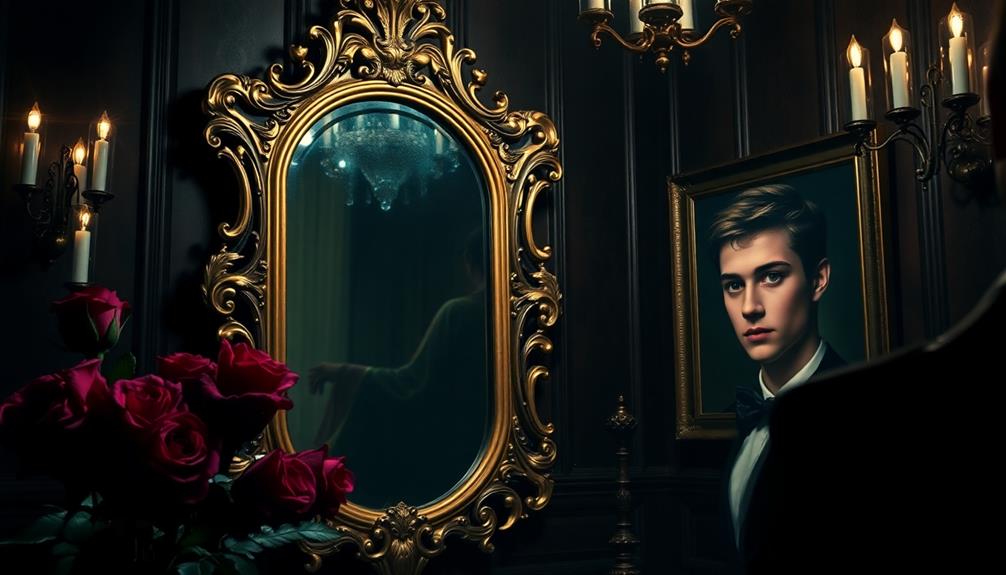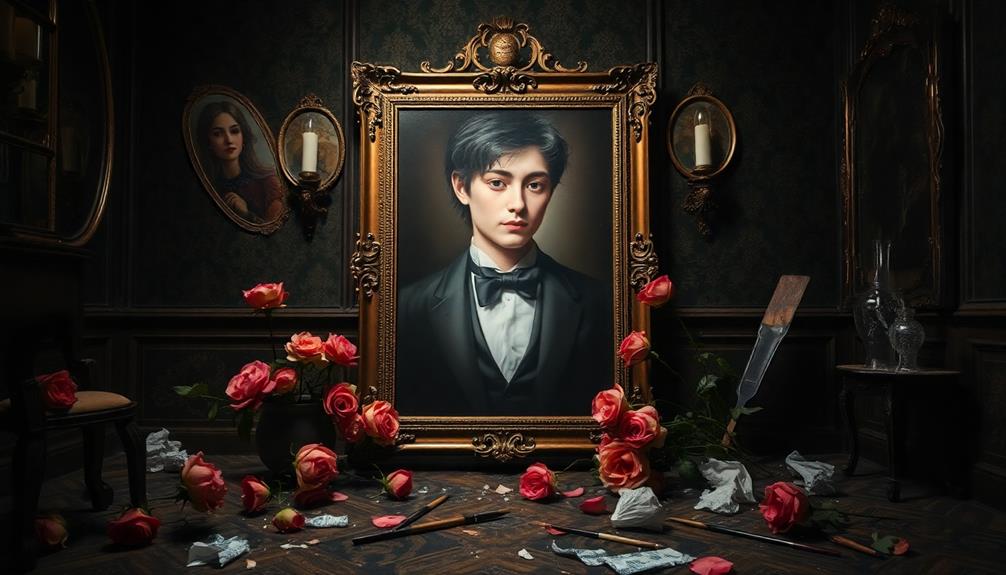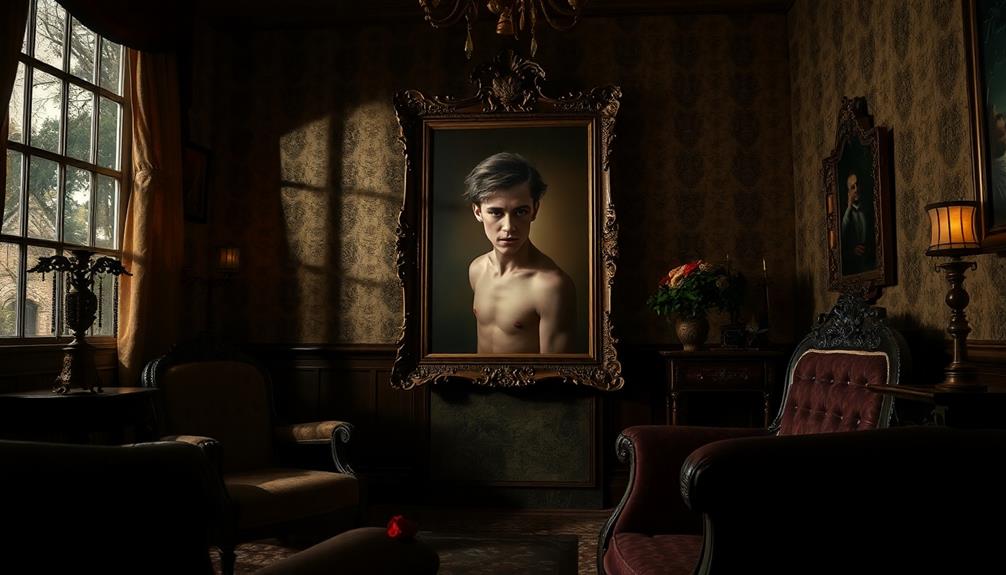Oscar Wilde's "The Picture of Dorian Gray" draws you into a dark and compelling world where beauty clashes with morality. You'll meet Dorian, who embodies youthful allure and unchecked desire, influenced by Lord Henry's hedonistic philosophy. The story explores profound themes like the duality of human nature, the pursuit of pleasure, and the inevitable decay of innocence. As the novel unfolds, the haunting portrait symbolizes Dorian's inner corruption, revealing the stark consequences of his choices. Wilde's genius lies in his ability to weave complex characters and themes, inviting you to rethink the relationship between art and ethics. There's much more to uncover.
Overview and Publication History
Oscar Wilde's "The Picture of Dorian Gray" is a pivotal work that first appeared in 1890 in Lippincott's Monthly Magazine, where it was initially published in a shorter format. This initial version sparked controversy due to its themes of immorality and hedonism, which clashed with the rigid standards of Victorian morality.
Much like the characters in the struggles against oppression in *The Book Thief*, Wilde's characters navigate a world fraught with societal constraints and moral dilemmas. Responding to criticism, Wilde expanded the narrative in the 1891 book release, adding six additional chapters that enhanced character development and thematic exploration, which enhanced the novel's literary merit.
As you explore its publication history, you'll notice how "The Picture of Dorian Gray" became emblematic of the aesthetic movement, promoting beauty and artistic expression over moral constraints.
However, its provocative content also led to Wilde facing charges related to homosexuality during his infamous 1895 trial, where the book was cited as evidence against him. The public reception was a complex mix of outrage and fascination, solidifying the novel's status as a classic.
This blend of admiration and condemnation reflects the tension between artistic freedom and societal norms, ensuring that Wilde's work remains relevant and thought-provoking to this day.
Character Analysis and Dynamics
The intricate character dynamics in "The Picture of Dorian Gray" reveal the profound effects of beauty, influence, and moral decay. Dorian Gray embodies the allure of youth and beauty while spiraling into a hedonistic lifestyle, largely fueled by Lord Henry Wotton. In a way reminiscent of the fragility of individual freedom in dystopian narratives, Dorian's journey emphasizes how easily one can fall prey to external pressures and societal expectations Totalitarian Regimes and Control.
Lord Henry serves as a catalyst, urging Dorian to pursue pleasure above all, effectively dismantling his moral compass. This relationship showcases the seductive power of influence, illustrating how easily Dorian succumbs to temptation.
In contrast, Basil Hallward represents moral conscience, deeply affected by his admiration for Dorian. Their relationship is fraught with emotional complexity; Dorian's charm brings Basil both joy and pain, ultimately leading to Basil's tragic fate when he confronts Dorian's corruption.
Sibyl Vane, Dorian's love interest, symbolizes innocence and tragedy. Her heartbreaking suicide becomes a pivotal moment that drives Dorian further into moral decline. As he grapples with the consequences of his actions, Dorian's character transforms from an innocent youth into a figure of self-absorption, highlighting the destructive nature of unchecked desire and the impact of external influences on one's soul.
Major Themes Explored

Exploring the major themes in "The Picture of Dorian Gray" reveals a rich tapestry of ideas that challenge our understanding of beauty, morality, and the human condition. At the heart of the narrative lies aestheticism, which prioritizes beauty and sensory experiences over ethical considerations. This conflict is embodied in Dorian Gray, whose life exemplifies the duality of human nature; he possesses exquisite beauty while harboring deep moral corruption.
Similar to the characters in *The Secret History*, Dorian's journey reflects the risks associated with elitism and obsession within artistic pursuits, ultimately leading to destructive consequences the allure of dark academia.
The consequences of hedonism are starkly portrayed as Dorian's relentless pursuit of pleasure leads to tragedy and self-destruction. His relationship with art is particularly poignant, symbolized by the portrait that reflects his decaying soul, contrasting with his youthful appearance. This portrait serves as a chilling reminder of the repercussions of his choices.
Additionally, the tension between mortality and immortality underscores Dorian's desire for eternal youth, illustrating the inevitable consequences of attempting to escape aging and moral responsibility.
Wilde weaves these themes together, compelling you to confront the darker aspects of beauty and the cost of a life lived without regard for moral integrity.
Critical Reception and Legacy
Upon its release in 1890, "The Picture of Dorian Gray" sparked fierce debates over its perceived immorality, marking a tumultuous start for Wilde's literary career. The initial critical reception was overwhelmingly negative, as many saw the novel as an affront to societal norms. This controversy intensified when it became a key piece of evidence during Wilde's 1895 trial for homosexuality, linking themes of immorality directly to his identity.
Similar to Ta-Nehisi Coates' exploration of complex societal issues in the impact of systemic oppression, Wilde's work challenges readers to confront uncomfortable truths about morality and identity.
Despite this rocky beginning, Wilde's novel has carved out a significant legacy, demonstrated by:
- Literary Merit: Critics now celebrate its exploration of aesthetics and morality.
- Influence on Identity: The novel's themes challenge traditional notions of self and societal expectations.
- Adaptations: It has inspired numerous films, plays, and media, including the acclaimed 1945 film directed by Albert Lewin.
- Ongoing Relevance: Discussions around beauty, ethics, and human nature continue to resonate today.
Ultimately, "The Picture of Dorian Gray" has evolved from a controversial debut to a classic, solidifying Oscar Wilde's place in literary history and prompting ongoing dialogue about morality and aesthetics.
Symbolism and Artistic Expression

Symbolism permeates "The Picture of Dorian Gray," deeply enriching its narrative and inviting readers to reflect on the interplay between art and morality. The portrait of Dorian serves as a powerful symbol of his inner corruption, starkly contrasting with his unchanging outward beauty.
Wilde critiques the hedonistic pursuit of pleasure, showcasing how aestheticism can lead to ethical decay. This theme resonates with the exploration of personal growth and resilience found in classic literature like David Copperfield, where characters navigate their struggles against societal norms. Through characters like Lord Henry, you see the superficiality of society, where beauty is valued above morality.
Nature's rich symbolism enhances this theme, with lush settings and wilting flowers that mirror life's transient beauty. Each element reflects the duality of existence—what appears beautiful can harbor darkness.
Wilde's use of epigrams and paradoxes amplifies the complexities of artistic expression, revealing deeper meanings behind the allure of beauty.
Conclusion
In exploring Oscar Wilde's "The Picture of Dorian Gray," you uncover a masterpiece that not only critiques Victorian society but also investigates the complexities of human nature. With over 250 adaptations across various media since its publication in 1890, Wilde's work continues to resonate. This enduring legacy highlights the novel's profound impact on literature and culture. By embracing its themes and symbolism, you're able to appreciate the genius that has captivated readers for generations.



